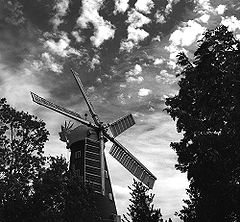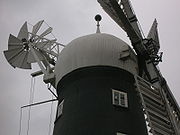
Alford Windmill
Encyclopedia

Windmill
A windmill is a machine which converts the energy of wind into rotational energy by means of vanes called sails or blades. Originally windmills were developed for milling grain for food production. In the course of history the windmill was adapted to many other industrial uses. An important...
in Alford
Alford, Lincolnshire
- Notable residents :* Captain John Smith who lived in nearby Willoughby* Anne Hutchinson, pioneer settler and religious reformer in the United States* Thomas Paine, who was an excise officer in the town....
, Lincolnshire
Lincolnshire
Lincolnshire is a county in the east of England. It borders Norfolk to the south east, Cambridgeshire to the south, Rutland to the south west, Leicestershire and Nottinghamshire to the west, South Yorkshire to the north west, and the East Riding of Yorkshire to the north. It also borders...
and the only surviving windmill out of four. Today the windmill has been restored to working order, and grinds grain to organic
Organic food
Organic foods are foods that are produced using methods that do not involve modern synthetic inputs such as synthetic pesticides and chemical fertilizers, do not contain genetically modified organisms, and are not processed using irradiation, industrial solvents, or chemical food additives.For the...
flour
Flour
Flour is a powder which is made by grinding cereal grains, other seeds or roots . It is the main ingredient of bread, which is a staple food for many cultures, making the availability of adequate supplies of flour a major economic and political issue at various times throughout history...
. It is open as a tourist attraction.
Construction

Tower mill
A tower mill is a type of windmill which consists of a brick or stone tower, on top of which sits a roof or cap which can be turned to bring the sails into the wind....
with a stage – featuring a slender, tapering brick tower, tarred to keep the moisture out, covered with a white onion-shaped (ogee) cap with fan-stage, huge fantail
Windmill fantail
A Fantail is a small windmill mounted at right angles to the sails, at the rear of the windmill, and which turns the cap automatically to bring it into the wind. The fantail was patented in 1745 by Edmund Lee, a blacksmith working at Brockmill Forge near Wigan, England, and perfected on mills...
, and white sails. She has five patent-shutter sails and originally three, later on four pair of stones (two pair of grey or peak stones (cut from rock found in the Peak District
Peak District
The Peak District is an upland area in central and northern England, lying mainly in northern Derbyshire, but also covering parts of Cheshire, Greater Manchester, Staffordshire, and South and West Yorkshire....
) and two French "quartzite
Quartzite
Quartzite is a hard metamorphic rock which was originally sandstone. Sandstone is converted into quartzite through heating and pressure usually related to tectonic compression within orogenic belts. Pure quartzite is usually white to gray, though quartzites often occur in various shades of pink...
" stones).
The Seven Storeys
- ground floor (contains a hurst frame with the engine-driven (from the outside) fourth pair of (grey) stones)
- storage floor
- spout (stage) floor (also called meal floor)
- stones floor (with the original three pairs of stones (one grey pair, two French pairs)
- lower bin floor
- upper bin floor (with the sack hoistHoist (device)A hoist is a device used for lifting or lowering a load by means of a drum or lift-wheel around which rope or chain wraps. It may be manually operated, electrically or pneumatically driven and may use chain, fiber or wire rope as its lifting medium. The load is attached to the hoist by means of a...
) - dust or cap floor (providing access to the inside of the cap)
The mill provides a flywheel at the mill's base connected by pulley to a town gas driven engine in the adjacent shed. This engine makes the mill independent of wind if it is insufficient to drive the sailcross. In its heyday Alford Mill was capable of grinding 4 to 5 tonnes of corn a day.
History

Millwright
A millwright is a craftsman or tradesman engaged with the construction and maintenance of machinery.Early millwrights were specialist carpenters who erected machines used in agriculture, food processing and processing lumber and paper...
John Oxley the mill belonged to a group of four windmills and is the sole survivor today. At the end of the 19th to the beginning of the 20th century Alford featured a four-sailed mill (Wallace's OR Station Mill, now a stump), a five-sailed windmill (Hoyles's Windmill, today's Alford Mill), and a six-sailer (the now dismantled (in 1973) six-storeyed Myers's Windmill, built in 1827 with six left-handed sails, and also called the Alford Mill) as the only place in Lincolnshire beside Horncastle.
The last commercial operators of the windmill were the Hoyles family. Purchased by Harry Hoyles, a local farmer and land owner, in the early 20th century, the business of milling and baking continued until 1955, run by his sons Walter, Arthur and Winston (The Miller). In those times the mill was known as the Hoyles's Mill. The business closed due to advancements in technology in 1955 and the mill was initially sold to Frank Banks of Kirton in Lindsey
Kirton in Lindsey
Kirton-in-Lindsey, also abbreviated to Kirton Lindsey, is a small town and civil parish in North Lincolnshire, England.-Geography:It is south of Scunthorpe, near the A15 road, and has a total resident population of 2,694....
in 1957, a private buyer and owner of Mount Pleasant Mill
Mount Pleasant Mill
Mount Pleasant Mill is a windmill north of Kirton-in-Lindsey on the North Cliff Road in North Lincolnshire in the east of England .-Construction:...
, who subsequently restored the windmill to working order. The last surviving windmill became then known as the Alford Windmill. Twenty years later in 1978 miller F. Banks had to replace the mill's cap and all five sails. The same year the mill changed hands to the Lincolnshire County Council which took care for the mill's restoration over many years resulting in the fine edifice that now once again plays its part in the local community. The mill remained leased to Mr Banks, the former owner, until 1986 when he gave up his milling business, his place being taken by James Waterfield of Boston in the following year, owner of the famous Maud Foster Windmill
Maud Foster Windmill
Maud Foster Windmill is a seven-storey, five sail windmill located by the Maud Foster Drain in Skirbeck, Boston, Lincolnshire, which she takes her name from...
. The mill was then leased to Mr Geoff Dees for some years, until the lease was sold in January 2010 to the current lease holder, Mr Ian Shepherd.

